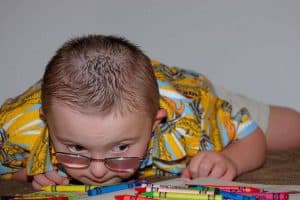Visual problems can have a large impact on the life of a child with austism.
Vision problems are common in children with ASD, but unfortunately these often go undiagnosed.
A recent study conducted in April 2018, called the Autism Prevalence Study, determined that 1 in 59 children are affected by Autism Spectrum Disorder (ASD)— a higher prevalence reported among boys, with 1 in 37 as compared to 1 in 92 girls.
Autism Spectrum Disorder is a range of childhood developmental conditions characterized by social, behavioral, and communication deficits.
- Many individuals with ASD have problems with sensory integration.
- ASD can affect the child’s visual skills as well as other sensory-processing abilities.
Eye exams for children with autism
It is crucial for parents to understand that children with ASD need to have regular eye exams in order to assess their ocular health, as well as their vision acuity. A standard 20/20 vision screening is insufficient.
Doctors also recommend that children with ASD have a functional visual evaluation in order to assess many other important aspects of the visual system, namely: eye movements, eye teaming, eye tracking, visual processing, visual-spatial judgment, and central/peripheral vision.
According to research, children with ASD present with a higher incidence of strabismus (eye turn) ranging from 21-50 percent prevalence, as compared to children without ASD.
Autistic behaviors and vision problems
Common autistic behaviors may seem unrelated to vision problems — though truthfully, many of the following behaviors actually present as a result of reduced vision or visual skills.
- Poor eye contact
- Looking beyond/through objects
- Absence of reciprocal play
- Extreme fear of heights or absence of appropriate fear of heights
- Tracking moving objects accurately
- Maintaining eye contact with people
- Eye alignment (eye turns)
- Keeping their eyes from wandering (amblyopia/lazy eye)
- Light sensitivity
- Head turning (looking at objects from the side of the eyes)
- Fleeting views or rolling eyes
- Visual stimming (flapping fingers in front of eyes)
If your child displays any of these vision problems contact an eye doctor near you who has experience with vision therapy.
SEE RELATED: Outsmarting Autism
Vision therapy for children with autism
Vision therapy is a highly effective treatment method, designed to enhance visual skills and the neurological connections between the eyes and brain.
A vision therapy program for a child with ASD will facilitate improved visual processing, enabling them to understand their surroundings with greater certainty— and consequently improve associated behaviors such as anxiety, social skills, and verbal skills.
Each therapy program is personalized to the needs of the child, and includes age-appropriate exercises and activities.
Common vision therapy goals for children with ASD include the improvement of:
- Visual-spatial organization
- Peripheral stability
- Central vision
- Efficient eye coordination
- Visual information processing
Prism lenses (yoked prisms or ambient prisms)
Many times, vision problems, specifically visual-spatial misperceptions such as body/objects/people moving in space, can cause a child with ASD to feel anxious, confused, or distressed— resulting in certain behavioral responses, discussed above.
Prism lenses have been created to help children with ASD to use their vision in a more effective and positive way. For example, prisms can create immediate improvements in posture, balance, and attention— significantly increasing the child’s feelings of physical safety and comfort, while decreasing anxiety and sensory overload.
The prism lenses can be worn daily or just for the duration of a vision therapy program, and typically facilitate significant improvements.
The goal of vision therapy for your child
The goal of optometric care for children with ASD is to facilitate the performance of everyday tasks, and minimize the challenges that both you as the parent, and your child, face on a daily basis.
LEARN MORE: Vision for Special Needs
If your child has autism, schedule a comprehensive eye exam to enable a proper diagnosis of any visual difficulties.










